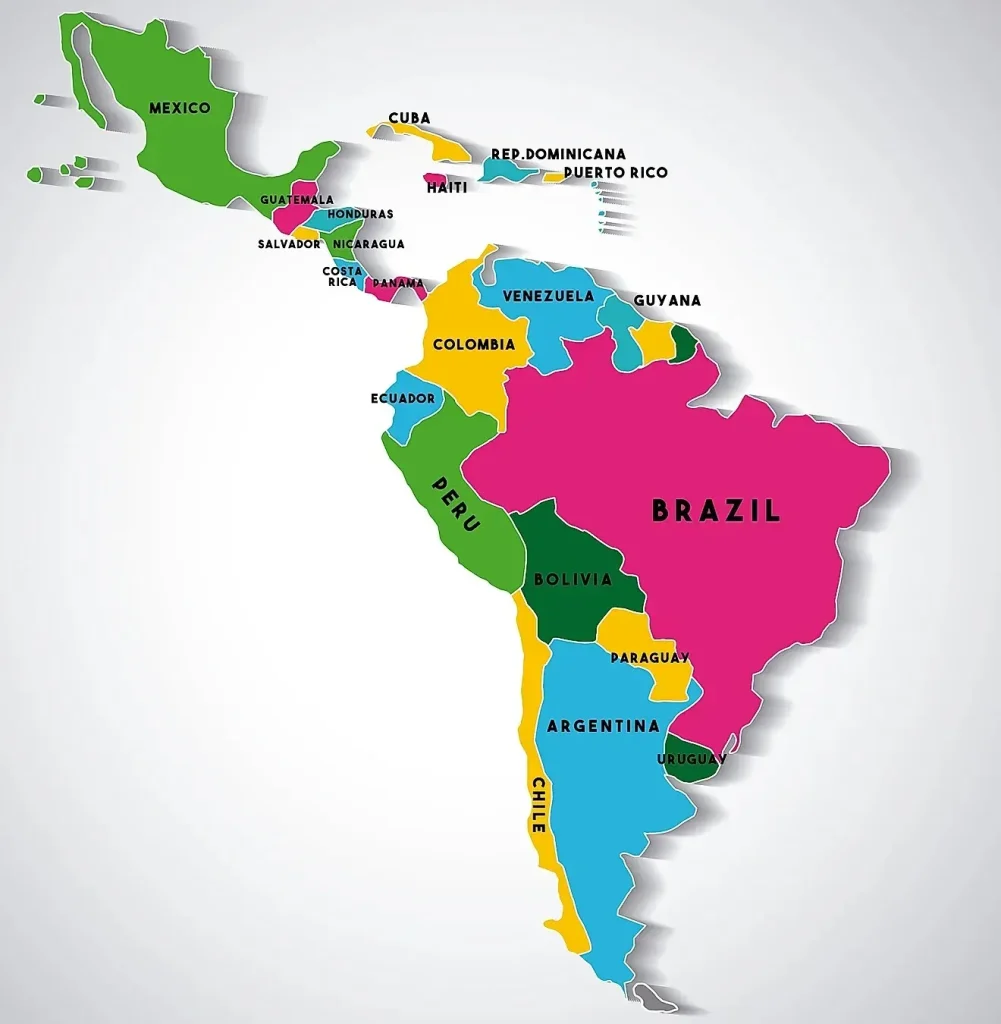America and Latin America share a complex and intertwined history that reflects a rich tapestry of cultural, political, and social narratives. Pulitzer Prize winner Greg Grandin’s exploration of Latin America history reveals not just the struggles and triumphs experienced by Latin Americans, but also their integral role in shaping the United States’ identity. From the colonial influence of figures like Simón Bolívar to the significance of the Monroe Doctrine, the connections between these regions are profound and multifaceted. Even recent political rhetoric, such as Trump’s rebranding of the Gulf of Mexico to the Gulf of America, highlights the ongoing debate about identity and sovereignty in the American hemisphere. Understanding these relationships is essential for grasping how the past continues to inform the present and future dynamics between America and Latin America.
The narrative of America and its southern counterparts, often referred to as Latin America, encompasses diverse experiences and historical relationships. As contemporary discourse evolves, many find themselves navigating the shared legacies of independence movements initiated by leaders like Bolívar and influenced by early U.S. philosophies. The emergence of the Monroe Doctrine and its varied interpretations have left an indelible mark on geopolitical interactions, shaping perceptions and policies that reverberate today. Domestically, the political landscape is reflective of broader ideological battles, influencing how both regions perceive issues of governance, freedom, and democracy. Exploring these dimensions offers insights into the mutual respect and tension that continues to characterize the Americas.
Understanding America’s Impact on Latin America
The perception of America varies significantly across geographical and cultural lines, particularly between the United States and Latin America. For many in Latin America, the term ‘America’ encompasses all the diverse nations and cultures from Tierra del Fuego to the Arctic territories of Canada. This comprehensive understanding contrasts sharply with the U.S. inclination to designate ‘America’ solely to itself. This contrast in interpretation underscores not only a linguistic divide but also deep historical and political implications that continue to shape U.S.-Latin American relations.
Historically, Latin Americans have viewed the United States as an expansive and often intrusive neighbor since the birth of the Monroe Doctrine in the early nineteenth century. This doctrine, which aimed to curb European intervention in the Americas, has been manipulated to further U.S. interests often at the expense of Latin American sovereignty. Leaders like Simón Bolívar initially welcomed Monroe’s promises of protection, only to later perceive U.S. actions as imperialistic. Thus, the relationship has been fraught with complexities, where the U.S. often sees itself as a sector of ‘America,’ while Latin Americans assert their identity as integral to a larger American identity.
The Monroe Doctrine’s Legacy in Modern America
The Monroe Doctrine, first articulated in 1823, has left an indelible mark on U.S.-Latin American relations, embodying both a protective and predatory stance. Initially intended to deter European powers from colonizing Latin America, its interpretation has shifted dramatically over the centuries. U.S. leaders frequently invoked it to justify interventions in Latin American affairs, often depicting such actions as benevolent or protective, while in reality, they were often exploitative. This contradiction has led to a recurring sentiment of distrust among Latin American nations, who have witnessed firsthand the ramifications of U.S. foreign policy that occasionally masquerades as a commitment to democracy and freedom.
As President Trump redefined phrases like ‘Gulf of America,’ it has reignited discussions around the Monroe Doctrine’s role in contemporary geopolitics. Trump’s executive order can be seen as an attempt to assert dominance, reflecting historical notions of American exceptionalism. Meanwhile, Latin Americans regard such maneuvers with skepticism, interpreting them as a continuation of a colonial mindset. The legacy of the Monroe Doctrine also informs current debates about borders, sovereignty, and regional collaboration, challenging leaders and thinkers to reconcile past injustices with a vision for a more equitable future within the broader American identity.
Bolívar and His Vision for a United America
Simón Bolívar famously envisioned a unified America, where nations across North and South would stand together against tyranny and oppression. His aspirations for a democratic and cooperative continent stood in stark contrast to the views held by many U.S. Founding Fathers. Bolívar admired the American Revolution and saw the potential for a shared destiny for all the peoples of the continent. His belief in cooperation among the Americas as a means to enhance their political virtues continues to resonate, despite the historical hurdles created by U.S. interventions that often undermined such ideals.
The dream of a unified America goes beyond Bolívar’s era; it carries significant weight today as Latin American countries grapple with internal divisions and external pressures. Grandin’s exploration of this historical narrative sheds light on Bolívar’s complex relationships with the U.S., particularly as perceptions have shifted from admiration to wariness over time. His legacy serves as a reminder that strength lies in unity, opposing the often fragmented and adversarial stance that U.S. foreign policy has historically adopted.
Greg Grandin’s Insights on America’s Past
In his works, particularly “America, América,” Greg Grandin draws on the rich history of interactions between the United States and Latin America, highlighting how narratives of conquest and colonization are pivotal in understanding the present dynamics. He chronicles the evolution of American identity alongside the struggles faced by Latin American nations in asserting their sovereignty. Grandin’s analysis encourages readers to reflect on how deeply intertwined these histories are, suggesting that today’s conflicts often have roots in historical grievances and alliances that were formed out of necessity or choice.
Grandin’s portrayal of the tension between an expansive U.S. self-image and the diverse identities of Latin America sheds light on the misunderstandings and assumptions that have pervaded relationships for centuries. His focus on historical figures, including Bolívar and Cortés, illustrates the complex legacies that continue to shape current political climates. By challenging readers to reconsider these narratives, Grandin opens the discussion on how America’s past informs its policies and how Latin America’s perspective must be integrated into a fuller understanding of what it means to be truly ‘American’.
The Role of Interventions in Shaping Identities
Throughout history, U.S. interventions in Latin America have been justified under various guises—national security, the spread of democracy, or economic stabilization. However, these actions have often led to destabilization, deepening divisions within Latin societies. By dissecting these patterns, Grandin indicates that these interventions have played a crucial role in shaping not only the landscape of political power but also the identities of nations within Latin America. Each intervention evokes a response that can solidify national pride, collective memory, and cultural consciousness, often allowing for a reassertion of sovereignty.
The implications of these historical interventions resound in modern politics, where leaders harness memories of past U.S. actions to galvanize support or critique foreign relations. Latin American identities are continually molded in reaction to these interventions, resulting in rich, complex narratives about resistance and resilience. As communities across Latin America navigate their history with the U.S., they actively construct identities that emphasize their agency and potential for collaboration, reflecting a desire to redefine the meaning of being ‘American’ in the hemisphere.
Language, Identity, and the Concept of ‘America’
Language plays a pivotal role in shaping identity, particularly in the context of how ‘America’ is perceived. For many in Latin America, the term encompasses a vast array of cultural and historical experiences, emphasizing a hemispheric identity rather than a U.S.-centric one. This linguistic nuance is often overlooked, fostering misunderstandings that can lead to tension. Grandin’s work highlights the critical importance of recognizing these linguistic differences as they relate to broader questions of identity, nationalism, and belonging within the Americas.
As people engage in discussions about what it means to be ‘American,’ it becomes essential to acknowledge the diverse interpretations tied to this concept. Latin Americans adopt a broader definition that inclusively celebrates the continent’s varied cultures, landscapes, and histories. The movement towards a unified acknowledgment of this identity reflects a growing awareness of shared experiences, struggles, and aspirations among the populations of the Americas, promoting a more comprehensive understanding of what it means to be connected across borders.
Democratic Movements and Rights Across the Americas
Social democracy has proven to be a salient theme throughout Latin American history, as many figures and movements have championed the rights of citizens, emphasizing equality and justice. Leaders such as Bolívar and contemporary figures like Lázaro Cárdenas sought not only political change but fundamentally aimed for social improvements that addressed underlying inequities. Grandin frames this historical struggle as essential in understanding contemporary movements today, as many Latin Americans continue to fight for their rights within frameworks that prioritize social democracy.
In contrast, the U.S. political landscape often evolves in reaction to such movements, grappling with its image as a leader of democracy while facing complexities in its domestic policies. The Latin American commitment to social justice stands in stark juxtaposition with the historical narratives often propagated by the U.S., where interventionist policies may undermine the very democratic principles purportedly supported. As social democracy encounters new challenges, Grandin underscores that recognizing the diversity in ideological perspectives across the Americas is crucial to fostering constructive dialogues about the future.
Unequal Perspectives on Historical Narratives
The historical narratives shaped by figures such as Greg Grandin reveal the complexities of interpreting American history, particularly regarding the divergent perspectives between the U.S. and Latin America. While U.S. histories often celebrate expansion and democracy, Latin American accounts frequently depict a struggle against imperialism and a fight for sovereignty. By emphasizing the importance of these narratives, Grandin encourages a more nuanced understanding of the American identity rooted not just in triumph but also in the lessons of injustice and resilience.
Engaging with these differing perspectives is vital, as they reveal the historical injustices that continue to impact present-day interactions between and within nations. For instance, by reassessing the U.S. role in historical events such as interventions or support for authoritarian regimes, a clearer picture emerges of how these actions have shaped Latin America’s political and social climate. Acknowledging the complexity of these narratives allows for a more profound understanding of what reconciliation might look like between the two regions.
Future Collaborations Between North and South America
As we look toward the future, the possibility of collaboration between North and South America seems to hinge on a more equitable understanding of historical contexts and the significance of interconnectedness. In “America, América,” Grandin posits that a joint commitment to social democracy among nations can redefine relationships across the continent. This collaboration involves engaging with and learning from each other’s experiences to cultivate shared goals that prioritize human rights and social justice.
The concept of a united front transcends borders, encouraging exchanges that embrace cultural diversity and promote cooperative initiatives. The realization that the struggles for justice and democracy are not confined to geographical locations but resonate across the Americas can pave the way for progressive change. By forging genuine alliances based on mutual understanding and respect, the nations of the Americas have the opportunity to realize Bolívar’s vision of a unified continent that collectively navigates the challenges of the modern world.
Frequently Asked Questions
What significant role did Bolívar play in America’s relationship with Latin America?
Simón Bolívar, a key figure in Latin America’s struggle for independence, viewed the United States as a model of political integrity. He believed in a unified vision for the Americas, highlighting a shared identity between North and South America, which contrasts with historical U.S. perceptions that often marginalized Latin American countries.
How did the Monroe Doctrine shape U.S.-Latin America relations?
The Monroe Doctrine, articulated in 1823, asserted U.S. influence over Latin America, warning European powers against interfering in the hemisphere. Initially, it was welcomed by Latin American independence leaders like Bolívar, but it later became a tool for U.S. interventionism, complicating relationships with Latin American nations.
What impact did Trump’s executive order to rename the Gulf of Mexico have on Latin American perceptions of America?
Trump’s decision to rename the Gulf of Mexico to the Gulf of America sparked debate over the definition of ‘America.’ Many Latin Americans interpreted this as an attempt to assert U.S. dominance while also reclaiming a broader definition of America, including all Latin American countries, thereby challenging the traditional U.S.-centric view.
What insights does Greg Grandin provide about the history of Latin America and America?
In his book ‘America, América,’ Greg Grandin emphasizes the interconnected history of Latin America and the United States, tracing how colonialism, independence movements, and interventionism have shaped current relations. He argues for a recognition of shared struggles and identities across the Americas, positioning Latin America’s history as integral to understanding U.S. expansion.
How does the historical context of the U.S. affect current relations with Latin America?
The historical context of U.S. policies, including interventions justified by the Monroe Doctrine and the legacy of conquest, continues to influence current relations with Latin America. This history fosters a complex dynamic where past grievances and cultural identity clash with contemporary political ambitions and alliances.
What lessons can be drawn from Latin America’s history in relation to social democracy and U.S. policies?
Grandin suggests that Latin America’s ongoing struggles for social justice and democracy can inform future movements in the U.S. By learning from the successes and failures of Latin American social-democratic efforts, Americans can better navigate their political landscape and possibly foster collaborative efforts across the hemisphere.
In what ways have U.S. leaders historically misunderstood Latin American nations?
Historical U.S. leaders, including Thomas Jefferson and John Adams, often viewed Latin American nations as inferior or unfit for self-governance. This perspective not only created a divide but also perpetuated a narrative of U.S. exceptionalism that has negatively impacted relationships and fostered resentment among Latin Americans.
What are the current political trends in America and Latin America?
Current political trends show a divergence, with some Latin American countries leaning towards authoritarianism while others embrace social democracy. In the U.S., there are rising sentiments that echo historic fears of fascism. Understanding these trends requires recognizing the intertwined histories and cultural narratives of both America and Latin America.
How does the concept of America differ between U.S. citizens and Latin Americans?
For many U.S. citizens, ‘America’ often refers specifically to the United States, while Latin Americans view ‘America’ as encompassing the entire continent, from Chile to Canada. This divergence highlights a historical divide in cultural perception and identity that affects diplomatic and social relations.
What connections exist between U.S. foreign policy and Latin American history?
U.S. foreign policy toward Latin America has been heavily influenced by historical events, such as the Monroe Doctrine and the imperialist actions of past presidents. These connections reflect a pattern of interventionism which often undermines Latin America’s sovereignty, complicating diplomatic relations throughout history.
| Key Themes | Details |
|---|---|
| Definition of America | For many in the U.S., America is synonymous with the United States, while Latin Americans view ‘America’ as inclusive of all the Americas. |
| Historical Perspectives | Latin Americans have played significant roles in U.S. history, such as Bernardo de Gálvez aiding in the American Revolution. |
| Monroe Doctrine | Initially seen as supportive by Latin American leaders, it became a justification for U.S. interventions in Latin America. |
| Cultural Impact | The narrative of conquest and colonialism has shaped the historical relationship between the U.S. and Latin America. |
| Contemporary Relevance | Addressing current political climates, including comparisons to authoritarian regimes and the pursuit of social democracy in the region. |
Summary
America and Latin America share a complicated historical and cultural relationship that continues to shape contemporary political discourse. The concept of America varies significantly between these regions, with Latin Americans embracing a more inclusive perspective that encompasses the entire continent. Understanding this can enhance mutual respect and collaboration across various levels of governance and society, paving the way for a shared future rooted in democratic ideals and social justice.



